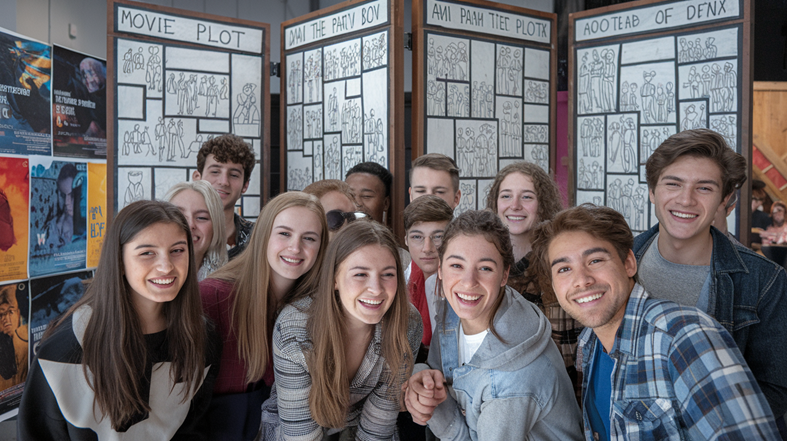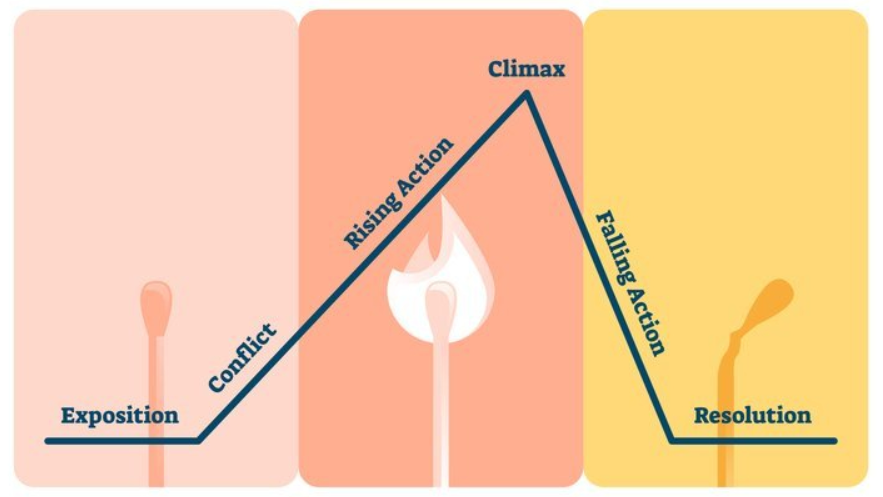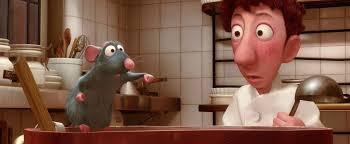Incorporating movies into your English learning journey offers numerous benefits, including:

- Enhanced understanding by providing context.
- Critical thinking and analytical skills improvement.
- Cultural awareness and empathy augmentation.
- More engaging and memorable learning.
- Boosted language acquisition through authentic use.
As you explore this lesson keep these benefits in mind. Happy learning!
MOVIES’ VOCABULARY AND IDIOMS

The following presentation will expand your movie vocabulary and introduce you to idioms that originated in films but are now commonly used in everyday conversations.
Learning Activities
Movie Clip Vocabulary Hunt
The teacher will select short clips from popular movies that include interesting vocabulary and idioms, with subtitles provided. In groups, you will watch the clips, read the subtitles, and write down a list of ten unfamiliar words or idioms you hear.
Afterwards, groups will exchange their lists. Using the context of the clips, each group will try to identify and write down the meaning of the words and idioms on the list they receive.
The first group to complete their list correctly will earn Krugs.
Create Your Own Movie Idiom
Individually or in pairs, invent a new idiom that could plausibly come from a movie. Create a backstory for your idiom, including the fictional movie title and the scene where it originated. Explain what your idiom means and how it would be used in conversation.
You’ll then present your new idioms to the class, and we’ll all vote on the most creative and practical ones. Krugs will be awarded to the creators of the top idioms.
NATIVE SPEAKERS’ VOCABULARY
Movies are a rich source of real-life language, offering key vocabulary and idioms used in everyday conversations among native speakers. See if you can identify this in the following clip.
Did you pick up on the following real-life expressions, idioms, and their meanings?
wit’
askin’
took you long enough
what’s up
a leap of faith
made ’em
don’t be a stranger
leap off of ’em
Many of these expressions and idioms aren’t typically taught in English courses because they aren’t formal or strictly grammatically correct. However, they are essential for engaging in conversations and communicating at a native-speaker level.
Movies are an excellent resource for learning this kind of real-life vocabulary, as they provide the context needed to understand how and when to use this expanded vocabulary effectively.
Additionally, watching movies helps you become accustomed to different English accents and accurately perceive correct word pronunciations.
Learn more in the following presentation:
Learning Activities
Culture Appreciation Game
The class will be divided into groups. All groups will watch clips of movies containing English cultural references on the class screen/TV. On a piece of paper, your group must write down all the references you identify in the clips. The group with the most correct references wins.
At the end, we will review the references and discuss why they might be missed by non-native members in an audience.
Movie Scene Reenactment
The teacher will select short, memorable scenes from popular movies that include native English phrases or idioms. Then, in small groups, you’ll pick one of the scenes, rehearse it, and perform the scene for the class. Try to focus on pronunciation, intonation, and delivering the lines naturally. After each performance, the class will discuss the idioms and phrases used in the scene and what they mean.
Movie Idiom Charades
There will be a box containing idioms or expressions from movies on slips of paper. The class will be divided into groups, and a member from each group will take turns drawing a slip. The group member must act out the idiom without speaking while the rest of the class tries to guess the phrase. After someone guesses correctly, we’ll discuss the meaning of the idiom and how it’s used in context. The group with the most correct guesses will earn Krugs for all members of their team.
Guess the Movie Line
The teacher will read from a list of famous movie lines that include native expressions or idioms. Your task is, on a piece of paper, to guess the movie or, in some cases, complete the famous line of dialogue. The student with the most correct guesses and completions will earn a reward.
After completing the list, the class will discuss the context of the lines, what they mean, and how the expressions might be used in everyday conversation.
MOVIE-BASED LISTENING COMPREHENSION

Listening to movies in English not only enhances listening skills but also makes the learning process engaging and enjoyable, as it combines education with entertainment.
Now that you’ve reached the C1 level, it’s time to transition from watching movies with subtitles to understanding them without any assistance, while still grasping most of what’s being said on screen.
In the following presentation, you’ll discover the next steps you can take as a C1 student to further improve your listening skills using movies.
Sample Exercise: Listening for Emotions
Next, we’ll move on to a sample exercise to apply some of the key points covered in the previous presentation.
Watch this scene from the movie without subtitles, focusing on how the characters express strong emotions.
Try to identify the emotions conveyed by each character, and observe the differences between this realistic example and typical academic English listening exercises.
-Did you notice how tone, pitch, and intonation helped convey the characters’ emotions?
-Also, did you pick up on how the pace of the conversation differs from the standard English recordings provided in courses or textbooks?
Even if you’re not living in an English-speaking country, watching movie scenes like this can expose you to the natural pace, tone, and intonation used by native speakers. This practice can help you avoid the “listening shock” when interacting with native speakers, allowing you to focus on both speaking and listening.
Learning Activities
Subtitles Translation
The teacher will play well-known movie scenes that feature several idioms and native-speaker expressions, but without subtitles. Working in pairs, you will recreate the subtitles for each scene on a piece of paper.
Afterward, pairs will exchange their subtitle recreations with another pair. The movie scenes will then be replayed with the original subtitles, and each pair will compare and mark the subtitles they received. Krugs will be awarded to the pair with the most accurate translation.
Shadowing Practice
A short movie scene will be played for you to listen carefully to the dialogue. The scene will then be replayed, and this time, you’ll “shadow” the characters by speaking along with them, closely mimicking their pronunciation and intonation.
For a chance to earn Krugs, you can perform the scene on your own, aiming to replicate the tone and pace of the original.
Soundtrack Quiz
The class will be divided into groups. The teacher will play soundtracks from well-known movies, and the first group to buzz in will have the opportunity to guess the movie. A correct guess earns a point for the group.
The team with the most points at the end will win 5 Krugs for each member.
Dialogue Fill-In-The-Blanks
You will be provided with a short movie clip and a transcript of said clip with some key words or phrases removed.
The clip will be played without subtitles. Listen carefully to fill in the blanks.
Afterward, we’ll review the answers together and discuss any difficult or unexpected phrases.
PLOT DEVELOPMENT AND ANALYSIS

Plot Development and Plot Analysis are the secret ingredients that make stories captivating, whether it’s in your favorite book or the latest blockbuster movie. In this lesson, we’ll use movies to discover what makes a story truly unforgettable, exploring the key elements that keep you hooked from start to finish.
Plot Development
Plot development refers to how a story’s events progress, evolve, and contribute to the overall narrative.
The six main parts of plot development are the following:

- Exposition: Introduces the background information necessary for understanding the story, such as the setting, characters, and initial situation.
- Conflict: The central struggle that drives the plot forward is introduced here. It can be an external or an internal conflict.
- Rising Action: Builds tension and develops the conflict through a series of events and challenges faced by the characters.
- Climax: The turning point or the most intense moment of the story, where the main conflict reaches its peak.
- Falling Action: Follows the climax and begins to resolve the story’s conflicts and subplots.
- Resolution (Denouement): Concludes the story by resolving any remaining conflicts and tying up loose ends.
Sample Plot Development: Ratatouille

Exposition:
Remy, a rat with a love for cooking, idolizes Chef Gusteau and dreams of becoming a chef in Paris.

Conflict:
Remy is torn between his passion for cooking and his reality as a rat, which is not welcome in kitchens.

Rising Action:
Remy partners with Linguini to secretly cook at Gusteau’s restaurant, gaining success while avoiding exposure by the head chef, Skinner.

Climax:
Remy prepares ratatouille for critic Anton Ego, who is profoundly moved, risking everything for this one dish.

Falling Action:
Gusteau’s restaurant closes after Skinner exposes Remy, but Ego’s review strengthens the main characters’ bond.

Resolution (or Denouement):
Remy, Linguini, and Colette open “La Ratatouille,” where Remy cooks openly, achieving his dream.
Plot Analysis
Plot analysis focuses on examining the structure and elements of the story to understand how the plot works and its impact on the overall narrative. Find out the key elements in the following presentation:
Learning Activities
Alternative Ending
Choose a favorite movie and write an alternative ending (resolution) or climax for it. You will present it in front of the class. Everyone will vote on the most creative one, and the winning student will earn Krugs.
Interactive Movie Script Rewrite
The teacher will provide you with a script from well-known movie scenes, but with certain key vocabulary and idioms missing. In groups, you’ll work together to rewrite one of the scenes, filling in the blanks with the appropriate idioms and vocabulary you’ve learned. You can choose to change the development of the plot or the tone of the scene if you want to.
Once you’ve completed your rewrites, each group will perform or read out the new version of the scene. We’ll then discuss as a class how your changes affected the scene’s tone and meaning. Krugs will be awarded for creativity and accuracy in the use of vocabulary and idioms.
FILM PROJECT
In groups of four or five, create a script for a short movie or trailer in a genre you enjoy. Then, film your project, ensuring it is at least 2 minutes long and includes subtitles.
To be handed in:
– Video file of the film/trailer
– Script of the planned scenes, including characters, and dialogue.
All movies and trailers will be showcased in class. The best one, as voted by your classmates, will earn Krugs for each member of the winning group.
